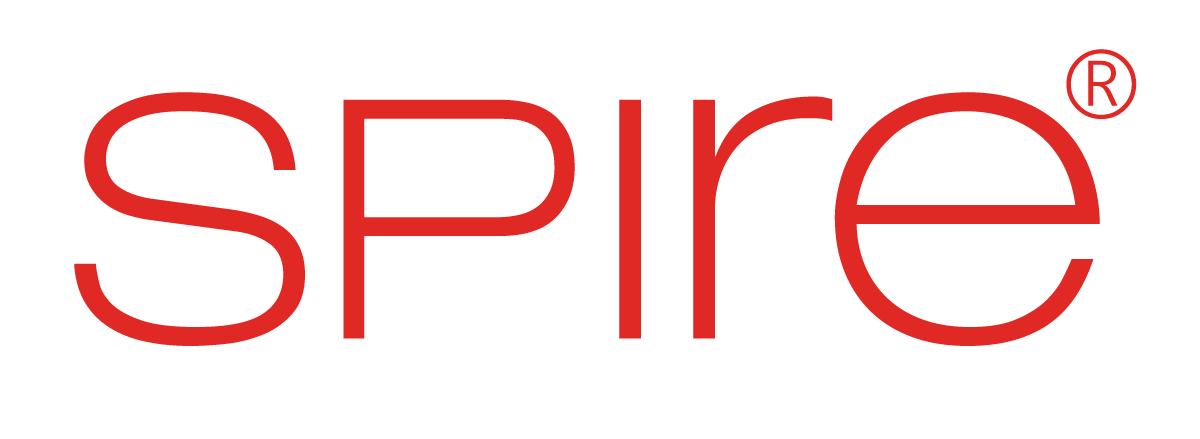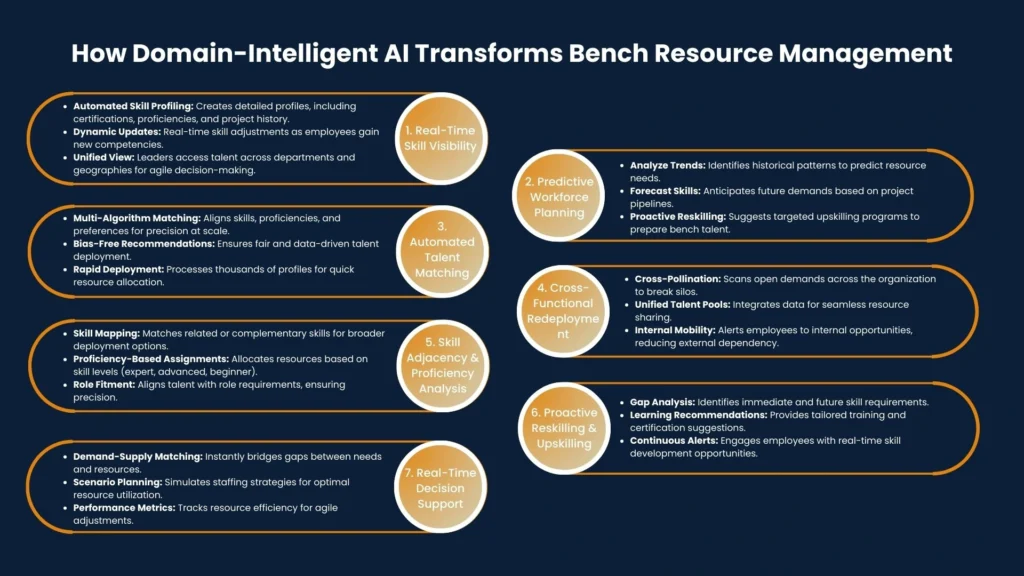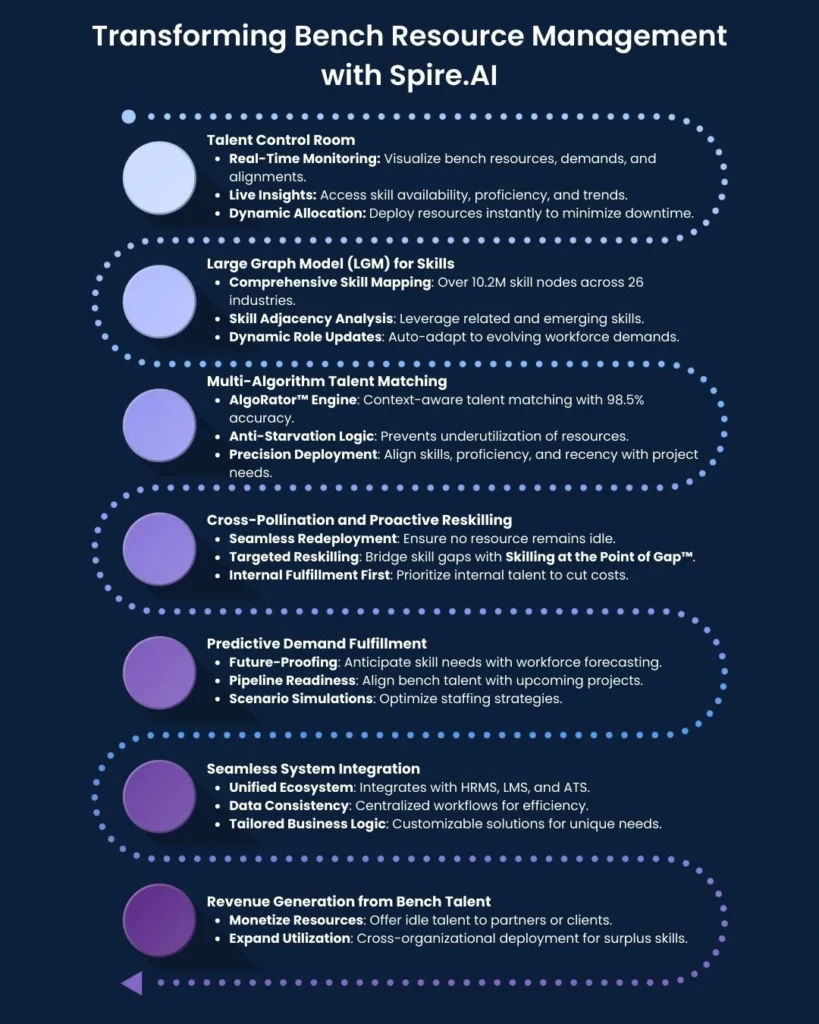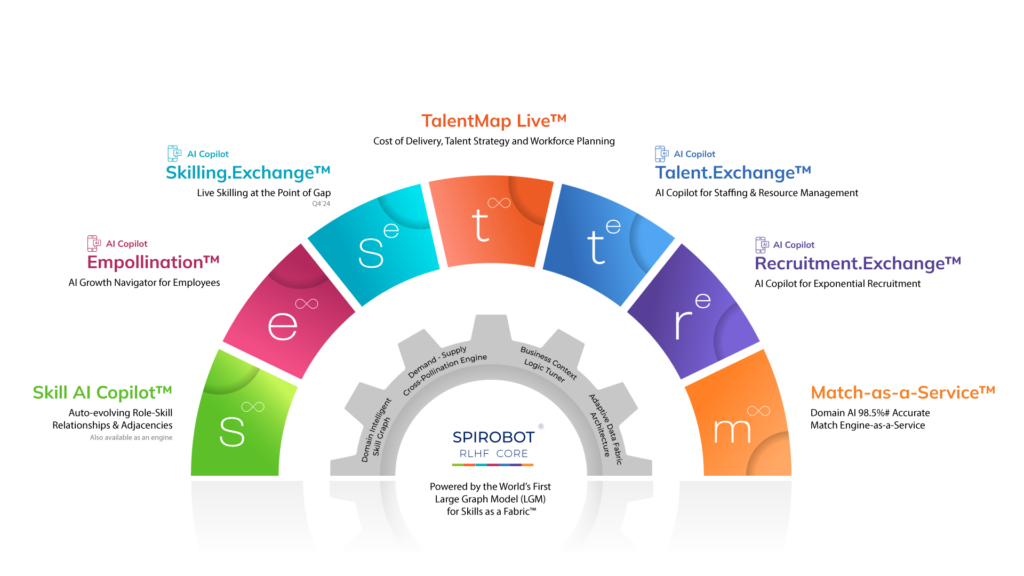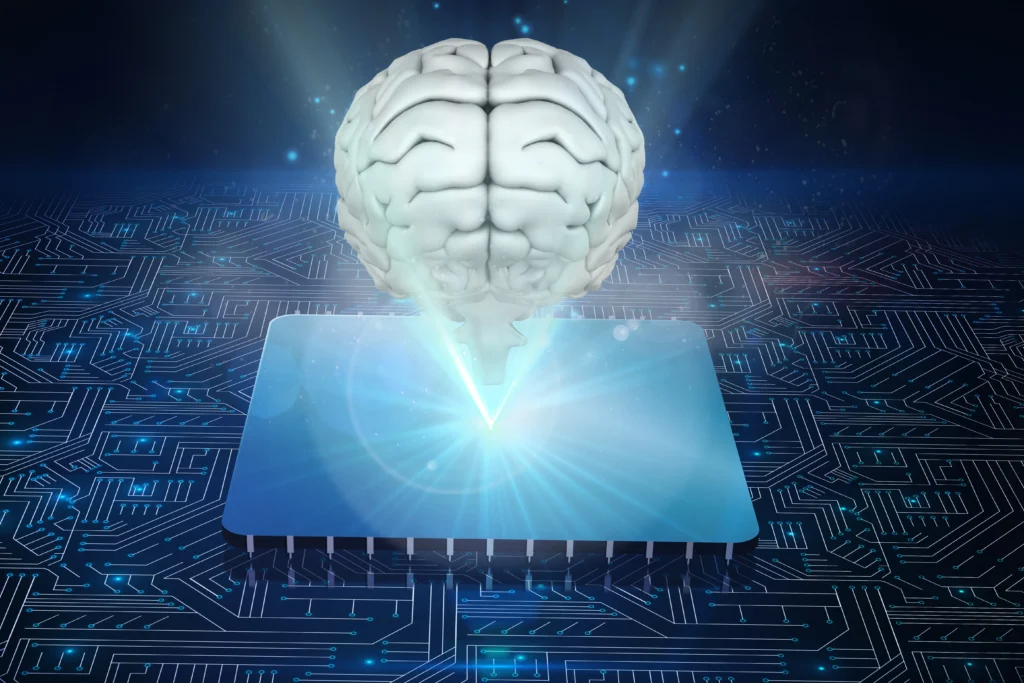Integrating Domain-Intelligent AI-driven talent deployment into bench resource management enables organizations to transform idle talent into active contributors to business outcomes. This technology leverages real-time skill visibility, predictive analytics, and automated matching to ensure seamless alignment between bench talent and project demands, driving workforce efficiency and delivering results at scale.
What Is Bench Resource Management?
To understand bench resource management, it is essential to understand the concept of bench resources. Bench resources refer to employees not assigned to billable or productive projects. These individuals, known as bench resources, are typically between assignments and are awaiting deployment to the next project.
Bench ResourcesEmployees not assigned to billable or productive projects. These individuals, known as bench resources, are typically between assignments and are awaiting deployment to the next project.
While maintaining a bench is often necessary to handle fluctuating workloads and unforeseen project demands, poor management can lead to inefficiencies such as:
- Escalating Costs: Idle employees still draw salaries without generating direct revenue.
- Wasted Potential: Skilled resources remain underutilized, missing opportunities to contribute to organizational goals.
- Morale and Retention Issues: Prolonged inactivity can lead to dissatisfaction, skill stagnation, and higher attrition rates.
Bench resource management aims to maximize the utilization of this workforce segment, ensuring that resources are efficiently redeployed, reskilled, or reallocated to meet organizational and client needs. The process involves forecasting demand, maintaining updated skill inventories, and deploying resources effectively.
The Challenges of Bench Resource Management in Project Delivery
Bench resource management becomes particularly critical when organizations must deliver high-stakes projects on time. Common challenges include:
- Escalated Operational Costs
Maintaining idle resources while incurring overhead costs drains budgets without generating returns. - Inefficient Talent Utilization
The lack of a clear understanding of bench talent’s skills results in suboptimal deployment, leaving resources underutilized. - Reactive Resource Planning
Traditional bench management relies on last-minute allocations, which create bottlenecks and fail to address project needs proactively.
These challenges call for a technology-driven, proactive approach to managing bench resources and maximizing project execution effectively.
How Domain-Intelligent AI Transforms Bench Resource Management
Domain-Intelligent AI brings a transformative approach to bench resource management, leveraging cutting-edge technologies to ensure precision, efficiency, and agility in managing idle talent. By combining advanced analytics with real-time decision-making capabilities, Domain-Intelligent AI addresses long-standing inefficiencies in bench management. Below is a detailed exploration of how Domain-Intelligent AI reshapes the management of bench resources.
1. Real-Time Skill Visibility and Inventory Management
Domain-Intelligent AI provides a dynamic and centralized view of workforce skills, enabling organizations to track and update employee capabilities continuously. This capability eliminates the blind spots caused by static or outdated skill inventories, ensuring decision-makers have instant access to accurate information. Features include:
- Automated Skill Profiling: Domain-Intelligent AI generates detailed profiles for every employee, encompassing certifications, proficiency levels, project history, and even soft skills.
- Dynamic Updates: Skills are updated in real-time as employees gain new certifications, complete projects, or develop adjacent competencies.
- Visibility Across the Organization: Leaders can identify available talent across departments and geographies, enabling cross-functional and global redeployment.
Domain-Intelligent AI maintains a live inventory and empowers organizations to make agile decisions, reducing the time to match resources to projects.
2. Predictive Analytics for Workforce Planning
One of the most valuable contributions of Domain-Intelligent AI is its ability to forecast future workforce needs through predictive analytics. This ensures that bench resources are ready for deployment before a demand arises. Predictive analytics achieves this by:
- Analyzing Historical Trends: Domain-Intelligent AI reviews past project data to identify patterns in resource requirements, skill shortages, and peak demand periods.
- Forecasting Skill Demands: The system anticipates upcoming skill requirements based on project pipelines, market trends, and client needs.
- Proactive Reskilling Recommendations: Predictive tools pinpoint skill gaps and suggest targeted reskilling or upskilling programs to prepare bench talent for future demands.
This foresight minimizes delays in staffing projects and optimizes capacity planning, ensuring that talent is always available and prepared when needed.
3. Automated Talent Matching
Traditional talent-matching processes rely heavily on manual intervention, leading to inefficiencies and mismatches. Domain-Intelligent AI revolutionizes this by automating the matching process with unparalleled accuracy. Key aspects include:
- Multi-Algorithm Matching: Domain-Intelligent AI evaluates skill adjacency, proficiency, recency, and even preferences such as location or project type using multiple simultaneous algorithms.
- Precision at Scale: The system can process and match thousands of profiles against equally complex project demands within seconds.
- Bias-Free Recommendations: Domain-Intelligent AI eliminates biases in manual matching processes by focusing solely on skill data and contextual factors.
This automated approach ensures resources are deployed to projects where they can deliver maximum impact, reducing idle time and improving project outcomes.
4. Cross-Functional Redeployment and Collaboration
One of the major challenges in bench resource management is the siloed nature of resource pools across departments or geographies. Domain-Intelligent AI addresses this by enabling seamless cross-functional redeployment, ensuring no resource remains underutilized. Highlights include:
- Cross-Pollination of Talent: The system continuously scans open demands and available talent across the organization, breaking down departmental silos.
- Unified Resource Pools: Domain-Intelligent AI integrates talent data from all business units, creating a single, unified resource pool accessible to all managers.
- Internal Talent Mobility: Employees are proactively alerted to opportunities in other departments, encouraging mobility and reducing dependency on external hires.
This capability optimizes resource allocation and fosters collaboration across teams, driving greater efficiency and innovation.
5. Skill Adjacency and Proficiency Analysis
Domain-Intelligent AI is designed to understand the nuanced relationships between skills, roles, and proficiency levels. It doesn’t merely match skills—it analyzes their context and potential for application in different scenarios. Features include:
- Skill Adjacency Mapping: Domain-Intelligent AI identifies related or complementary skills that can be leveraged in similar projects, broadening the scope for resource deployment.
- Proficiency-Based Assignments: Resources are allocated based on their skill levels (e.g., expert, advanced, or beginner), ensuring the right talent matches the right complexity of work.
- Role-Based Fitment: The system evaluates how well an employee’s skills align with the requirements of a specific role, considering factors such as experience, certification, and past performance.
This granular analysis ensures that projects are staffed with talent with the right skills and proficiency levels to meet expectations.
6. Proactive Reskilling and Upskilling
In addition to deploying bench resources, Domain-Intelligent AI actively works to make them more valuable to the organization. The system identifies gaps in an employee’s skills and provides personalized recommendations for growth. This includes:
- Gap Analysis: Domain-Intelligent AI compares an employee’s current skills against both immediate and future project requirements.
- Targeted Learning Recommendations: Employees receive suggestions for training programs, certifications, or mentorship opportunities to bridge their skill gaps.
- Continuous Development Alerts: Automated notifications ensure employees are aware of opportunities to improve their capabilities, keeping them engaged and motivated.
By aligning reskilling initiatives with organizational goals, Domain-Intelligent AI ensures bench talent remains relevant and ready for deployment.
7. Real-Time Decision Support
The dynamic nature of today’s business environment demands quick, informed decisions. Domain-Intelligent AI supports this through real-time insights and dashboards that provide:
- Live Demand-Supply Matching: Managers can instantly view and address gaps between project demands and available talent.
- Scenario Planning: The system simulates different staffing scenarios, helping organizations prepare for contingencies.
- Performance Tracking: Real-time metrics allow leaders to monitor how effectively bench resources are utilized and adjust as needed.
This capability empowers organizations to adapt quickly to changing priorities, ensuring projects remain on track.
Benefits of Domain-Intelligent AI in Bench Resource Management
Integrating Domain-Intelligent AI into bench resource management offers transformative benefits. It addresses traditional challenges with precision, scalability, and efficiency. Here’s an in-depth look at how this innovative technology can revolutionize organizations’ management of bench resources.
Benefits of Domain-Intelligent AI in Bench Resource Management
– Reduced Idle Time
– Optimized Productivity
– Automated Talent Matching
– Real-Time Decision-Making
– Reduced Recruitment Expenses
– Lower Overhead Costs
– Open New Revenue Streams
– Enhanced Resource Allocation
1. Enhanced Workforce Utilization
One of the most significant advantages of Domain-Intelligent AI is its ability to maximize the utilization of bench resources. Through real-time skill visibility and automated matching, the technology ensures idle employees are quickly deployed to projects where their skills are most needed. Key impacts include:
- Reduced Idle Time: AI ensures that resources are matched to open demands promptly, keeping bench time to a minimum.
- Optimized Productivity: Organizations see a measurable increase in workforce productivity by aligning employees with roles that best suit their skills.
This ability to activate underutilized talent helps organizations turn their bench into a strategic asset.
2. Faster Project Deliveries
Delays in deploying resources often lead to project setbacks and missed deadlines. Domain-Intelligent AI solves this problem by expediting the resource allocation process through:
- Automated Talent Matching: Multi-algorithm systems quickly match bench talent to open demands, eliminating the delays caused by manual processes.
- Real-Time Decision-Making: Live dashboards and analytics ensure that decision-makers can act swiftly to address project needs.
The result is reduced time-to-fulfill demands and a higher rate of on-time project completions, leading to better client satisfaction and enhanced business reputation.
3. Cost Optimization
Domain-Intelligent AI helps organizations save costs by prioritizing internal talent deployment over external hiring. This cost-saving approach includes:
- Reduced Recruitment Expenses: Leveraging internal resources reduces reliance on costly external hires.
- Minimized Opportunity Costs: By deploying resources faster, organizations can capitalize on revenue-generating opportunities without delays.
- Lower Overhead Costs: Efficient bench management ensures that salaries paid to idle resources contribute directly to productive outcomes.
Through these measures, Domain-Intelligent AI significantly enhances an organization’s financial efficiency.
4. Revenue Growth Through Bench Monetization
Domain-Intelligent AI enables organizations to monetize bench talent by identifying external opportunities for underutilized resources. By matching bench employees with client needs or creating opportunities to “sell” talent to partner organizations, businesses can:
- Turn Idle Talent Into Revenue: Bench resources become billable assets rather than operational costs.
- Open New Revenue Streams: External opportunities for surplus talent generate additional income while reducing internal bench costs.
This strategic use of AI turns a traditional cost center into a profit center, driving long-term financial benefits.
5. Strategic Workforce Planning
Domain-Intelligent AI supports long-term workforce planning by aligning employee skills with organizational objectives. Through predictive analytics and real-time insights, it enables organizations to:
- Prepare for Future Demands: Anticipate skill requirements and reskill employees proactively.
- Optimize Talent Mobility: Seamlessly move resources across projects and departments to address evolving business needs.
- Enhance Resource Allocation: Allocate resources based on immediate project needs and long-term strategic goals.
This approach ensures that workforce decisions contribute to organizational resilience and agility.
The Role of Spire.AI in Optimizing Bench Resource Management for Maximizing Project Delivery
Spire.AI transforms bench resource management by leveraging its Domain-Intelligent AI and the Large Graph Model (LGM) for Skills, offering precision, scalability, and insights unique to its capabilities. With Spire.AI solutions, organizations can address inefficiencies in bench resource management while aligning talent with project needs to enhance delivery timelines and outcomes. Here’s how Spire.AI enables organizations to achieve maximum value:
1. Talent Control Room for Real-Time Management
The Spire.AI Talent Control Room is a centralized hub for monitoring demand and supply. This feature allows organizations to visualize bench resources, track open demands, and identify alignment opportunities in real-time.
- Live Inventory and Insights: Gain a panoramic view of organizational skills, availability, and proficiency.
- Demand-Supply Trends: Predictive trends and actionable insights help decision-makers preemptively address talent gaps.
- Dynamic Resource Allocation: Managers can instantly assign bench resources to demands, ensuring minimal downtime and optimal alignment.
2. Large Graph Model (LGM) for Skills
The LGM for Skills is a core differentiator. It offers an advanced framework for understanding and contextualizing complex skill relationships, adjacencies, and gaps. It continuously evolves to adapt to changing workforce demands.
- Comprehensive Skill Mapping: The LGM uses over 10.2 million skill nodes and 125,000 unique primary skill nodes contextualized across 26 industries.
- Skill Adjacency and Depth Analysis: Understand skill adjacencies to deploy talent for related or emerging project needs, ensuring no resource is overlooked.
- Auto-Evolving Role-Skill Relationships: Spire.AI updates skill relationships dynamically, ensuring relevance in deployment decisions.
3. Multi-Algorithm Talent Matching
Spire.AI employs its AlgoRator™, a multi-algorithm matching engine that ensures precise alignment between bench talent and project demands.
- Contextual Matching Parameters: AlgoRator™ evaluates demand context, employee skill depth, proficiency, recency, and location.
- High Accuracy Rates: With a match accuracy of over 98.5%, Spire.AI ensures that projects are staffed with the best-suited resources.
- Anti-Starvation Logic: The Blue Ring Logic prevents demand and supply mismatches, eliminating the risk of underutilized resources.
4. Cross-pollination and Proactive Reskilling
The Spire.AI Cross-Pollinator Engine enables seamless redeployment of resources across business units and functions. It ensures that no bench resource remains idle while actively addressing skill shortages.
- Proactive Reskilling Alerts: The platform auto-identifies skill gaps and provides targeted learning paths for employees to bridge these gaps
- Skilling at the Point of Gap™: Reskilling recommendations are tailored to bridge immediate gaps, ensuring bench talent is project-ready.
- Internal First Fulfillment: Spire.AI prioritizes internal resources over external hiring, reducing costs and enhancing resource utilization.
5. Predictive Demand Fulfillment
The Demand Contextualization Engine by Spire.AI predicts workforce needs with unparalleled precision, enabling proactive preparation of bench resources.
- Demand Forecasting: The system anticipates upcoming skill requirements based on project pipelines and historical trends.
- Pipeline Readiness: Bench resources are aligned with future projects, minimizing delays and maximizing delivery efficiency.
- Scenario-Based Deployment: Simulate various staffing scenarios to ensure optimal resource allocation.
6. Seamless System Integration
Spire.AI integrates effortlessly with existing systems like HRMS, LMS, and ATS, creating a unified talent ecosystem.
- Data Consolidation: Centralized aggregation of data ensures consistency and eliminates silos.
- Unified Workflow Management: Spire.AI supports end-to-end bench management from skill profiling to deployment.
- Customizable Business Context Logic (BCL): Tailored to each organization’s unique operational needs, the BCL ensures alignment with strategic goals.
7. Generating Revenue from Bench Talent
Spire.AI helps organizations monetize surplus bench talent through external opportunities.
- Lend or Sell Bench Resources: Offer idle talent to partner organizations or clients to turn underutilized resources into revenue-generating assets.
- Intelligent Cross-Organizational Deployment: Spire.AI ensures the alignment of surplus talent with client needs, expanding utilization beyond internal projects.
Conclusion
Bench resource management, often seen as a challenge, can become a powerful driver of organizational success when approached strategically. Organizations can transform idle resources into indispensable contributors to project delivery and business growth with Spire.AI’s Domain-Intelligent AI and cutting-edge solutions like the Large Graph Model (LGM) for Skills. From real-time skill visibility and predictive demand planning to seamless redeployment and proactive reskilling, Spire.AI equips businesses with the tools to optimize every aspect of bench resource management.
The result? Faster project deliveries, reduced costs, improved workforce engagement, and a significant competitive advantage. For organizations looking to harness the untapped potential of their bench, Spire.AI isn’t just a solution—it’s a game-changer. The time to unlock the full value of your workforce is now.
